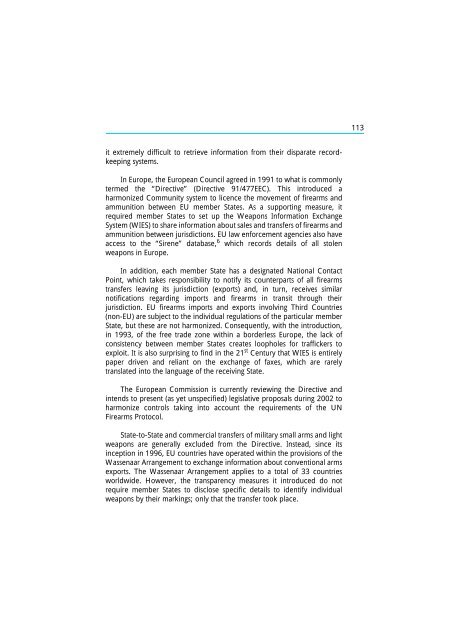The Scope and Implications of a Tracing Mechanism for Small Arms ...
The Scope and Implications of a Tracing Mechanism for Small Arms ...
The Scope and Implications of a Tracing Mechanism for Small Arms ...
Create successful ePaper yourself
Turn your PDF publications into a flip-book with our unique Google optimized e-Paper software.
113<br />
it extremely difficult to retrieve in<strong>for</strong>mation from their disparate recordkeeping<br />
systems.<br />
In Europe, the European Council agreed in 1991 to what is commonly<br />
termed the “Directive” (Directive 91/477EEC). This introduced a<br />
harmonized Community system to licence the movement <strong>of</strong> firearms <strong>and</strong><br />
ammunition between EU member States. As a supporting measure, it<br />
required member States to set up the Weapons In<strong>for</strong>mation Exchange<br />
System (WIES) to share in<strong>for</strong>mation about sales <strong>and</strong> transfers <strong>of</strong> firearms <strong>and</strong><br />
ammunition between jurisdictions. EU law en<strong>for</strong>cement agencies also have<br />
access to the “Sirene” database, 6 which records details <strong>of</strong> all stolen<br />
weapons in Europe.<br />
In addition, each member State has a designated National Contact<br />
Point, which takes responsibility to notify its counterparts <strong>of</strong> all firearms<br />
transfers leaving its jurisdiction (exports) <strong>and</strong>, in turn, receives similar<br />
notifications regarding imports <strong>and</strong> firearms in transit through their<br />
jurisdiction. EU firearms imports <strong>and</strong> exports involving Third Countries<br />
(non-EU) are subject to the individual regulations <strong>of</strong> the particular member<br />
State, but these are not harmonized. Consequently, with the introduction,<br />
in 1993, <strong>of</strong> the free trade zone within a borderless Europe, the lack <strong>of</strong><br />
consistency between member States creates loopholes <strong>for</strong> traffickers to<br />
exploit. It is also surprising to find in the 21 st Century that WIES is entirely<br />
paper driven <strong>and</strong> reliant on the exchange <strong>of</strong> faxes, which are rarely<br />
translated into the language <strong>of</strong> the receiving State.<br />
<strong>The</strong> European Commission is currently reviewing the Directive <strong>and</strong><br />
intends to present (as yet unspecified) legislative proposals during 2002 to<br />
harmonize controls taking into account the requirements <strong>of</strong> the UN<br />
Firearms Protocol.<br />
State-to-State <strong>and</strong> commercial transfers <strong>of</strong> military small arms <strong>and</strong> light<br />
weapons are generally excluded from the Directive. Instead, since its<br />
inception in 1996, EU countries have operated within the provisions <strong>of</strong> the<br />
Wassenaar Arrangement to exchange in<strong>for</strong>mation about conventional arms<br />
exports. <strong>The</strong> Wassenaar Arrangement applies to a total <strong>of</strong> 33 countries<br />
worldwide. However, the transparency measures it introduced do not<br />
require member States to disclose specific details to identify individual<br />
weapons by their markings; only that the transfer took place.
















